Various yoga poses have various benefits.The history of yoga is indeed very old. It was originated in India. The first book of yoga was written by Patanjali in 147 B.C. In fact, yoga means joining of body with soul.
The main aim of yoga poses is to make the body healthy, vigourous, elastic, and active along with increasing the efficiency and winning the mind. It also aim at salvation.
- Yama
- Niyama
- Asana
- Pranayama
- Pratyahara
- Dharana
- Dhayana
- Samadhi
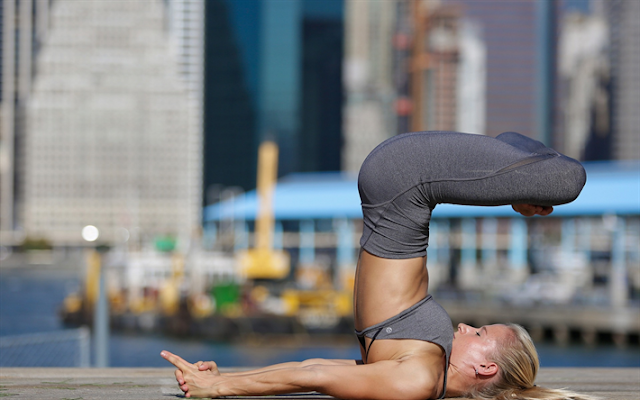
- Yoga poses should be practised in the morning. It is better to do yoga after taking bath.
- Yoga poses should be performed at peaceful and airy place.
- Yoga poses yields more results when done with full concentration.
- The practice of Asana should be increased gradually. It opens up the body and gives elasticity.
- We should be dressed scantily while performing yoga but during winters proper clothes should be worn.
- It can be performed by a person of any age. But prior to start practice, guidance should be taken from trained professional.
- These exercises should be performed with empty stomach. The meal should be taken after at least 2 hours of yoga Aasan.
- Pranayam should not be performed by a sick person.
- Shav Aasan must be performed after completing the yoga. Aasans benefit only when followed by shava Aasana.
- Helpful in strengthening the leg muscles.
- Helpful in increasing the height of the children.
- Helpful in removing leg pain.
- It makes the spine flexible and broaden the chest.
- Makes the neck, shoulders, chest and head more active.
- Increase the blood circulation.
- It gives power and flexibility to the body.
- It reduces obesity.
- It cures the liver diseases.
- Helpful in strengthening the digestive system.
- Helpful in strengthening the lung power.
- It increase the blood circulation.
- The spine and waist becomes flexible.
- It is very useful for Shoulders.
- Many stomach diseases like acidity. indigestion etc. are cured.
- It increases the memory power.
- It also cures the urinary problems and excessive saliva.
- It makes the spine flexible and reduce its stiffness.
- It reduces the obesity.
- It cure constipation and also stomach pains.
- It strengthens the muscles of arms legs and stomach.
- It increases the lung power power and breathing process.
- It cure the urinary diseases and arthritis.
- Helpful in strengthening the neck muscles.
- Helpful in reducing weight and back pain.
- Strengthens the backbone
- Improves the blood circulation.
- Improves memory.
- Cures backache and chest diseases.
- Helpful in concentration.
- Strengthens the thighs knees and toes.
- Improves the digestive system.
- Makes the body strong.
- It improves the blood circulation.
- It improve the digestive system.
- It reduces constipation.
- It makes the body active.
- It cure piles.
- It increases the flexibility of body.
- Backbone becomes flexible.
- Reduces fat.
- Strengthens the leg, feet, knee muscles.
- Cures many stomach diseases.
- Helpful in reducing obesity.
- Helpful in controlling diabetes and back pain.
- Strengthens the back muscles.
- Strengthens the thighs.
- Cures the gas trouble or acidity.
- It cure hypertension and mental stress.
- It refreshes the mind and body.
- It removes the fatigue.
- Anulom-Vilom :It is simple inhaling from left nostril, stopping breath for some time and then exhaling from right nostril and vice versa.
- Kapal-bhati :In this, a long inhale is taken where as forceful exhale is done from nose with pressure, while stomach is vibrated in and out.
- Bhramari :In this, the exhalation process combines with vibrating sound from the throat.
- Sitali Pranayama :In this, the mouth and lips are kept in an ‘O’ formation. The tongue should touch the teeth and the shape of tongue is like a curled leaf. Then the tongue is protruded and curled out of the lips. Inhale fully and hold it for 5 seconds; side by side neck is flexed, so that Chin touches sternum (chest bone). Exhale slowly.
- Sitakari Pranayama :In this technique, the tongue is not curled and lips are parted. The rest of technique is same as of Sitali Pranayama.
- Ujjai Pranayama :In this the air is inhaled through both nostrils. Hold the breath. Exhale slowly and deeply till the lungs get empty. This activity is done for five minutes.
- Bhastrika Pranayama :Bhastrika means a bellow used in a furnace. In it the air is forcibly drawn in and out.
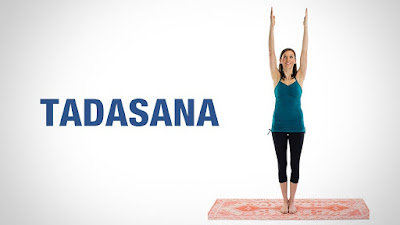 After standing join the heels and toes and raise the arms up the knees can also be left open according to the width of Shoulders. Palm should be upward and eyes should be looking straight. Take the breath in. Then raise the heels and lay your weight on the toes. Pull the body up and after sometime take the body down while breathing out. Repeat it for 10 to 15 times.
After standing join the heels and toes and raise the arms up the knees can also be left open according to the width of Shoulders. Palm should be upward and eyes should be looking straight. Take the breath in. Then raise the heels and lay your weight on the toes. Pull the body up and after sometime take the body down while breathing out. Repeat it for 10 to 15 times.
 It is also called as ‘Sarapa Aasan’. In this the position of body looks like a snake. To do this Asana lie down on the ground on your stomach, keeping the hands close to shoulders, raise the chest to such a level that arms gets straight this will be done while stretching the legs. Take the toes in and hang the head slowly behind. Slowly come in the initial position repeat this 3-5 times.
It is also called as ‘Sarapa Aasan’. In this the position of body looks like a snake. To do this Asana lie down on the ground on your stomach, keeping the hands close to shoulders, raise the chest to such a level that arms gets straight this will be done while stretching the legs. Take the toes in and hang the head slowly behind. Slowly come in the initial position repeat this 3-5 times.
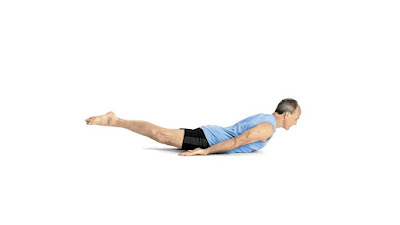 Technique of shalabhasanaLie down on the ground on your belly and put the palms on the ground. Join both the feet. Slowly raise the lower portion of the waist while keeping the legs straight. Stay in this position for sometime. Put both your hands beneath the stomach and raise the feet as high as possible. The front portion of the waist should touch the ground.
Technique of shalabhasanaLie down on the ground on your belly and put the palms on the ground. Join both the feet. Slowly raise the lower portion of the waist while keeping the legs straight. Stay in this position for sometime. Put both your hands beneath the stomach and raise the feet as high as possible. The front portion of the waist should touch the ground.
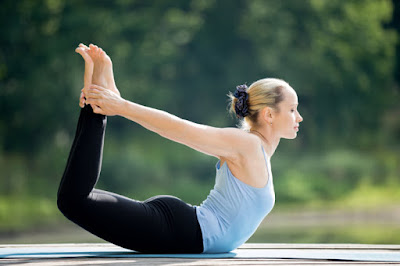 Technique :The body takes the shape of a bow. Lie down on the ground on your belly. Bend the knees backward. Hold the feet with hands below the ankles. Take a deep breath and raise the chest as high as possible. Now stretch the feet, so that body takes the shape of a bow. Stay in this position as long as you can. While breathing out, relax the body and come in the initial position. Repeat this Aasan for 3-4 times.
Technique :The body takes the shape of a bow. Lie down on the ground on your belly. Bend the knees backward. Hold the feet with hands below the ankles. Take a deep breath and raise the chest as high as possible. Now stretch the feet, so that body takes the shape of a bow. Stay in this position as long as you can. While breathing out, relax the body and come in the initial position. Repeat this Aasan for 3-4 times.
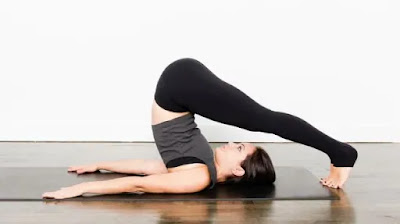 Technique :Lie straight on the ground. keep the palms along the body and put them straight on the ground. Slowly lift the lower part of body i.e. feet in a rhythm and touch the ground behind the head with the toes. Stay in this position for 10-15 seconds and then slowly come back to initial position.
Technique :Lie straight on the ground. keep the palms along the body and put them straight on the ground. Slowly lift the lower part of body i.e. feet in a rhythm and touch the ground behind the head with the toes. Stay in this position for 10-15 seconds and then slowly come back to initial position.
 Technique :Sit on your knees. Keep the head and waist exactly straight. Keep your hands on the knees in such a way that the palms should face downward. In this asana the heels should be exactly below the legs and waist should be exactly straight. The chest and neck should also be erect.
Technique :Sit on your knees. Keep the head and waist exactly straight. Keep your hands on the knees in such a way that the palms should face downward. In this asana the heels should be exactly below the legs and waist should be exactly straight. The chest and neck should also be erect.
 Technique :You should lie down on your back. Keep your hands near the body and slowly lift the feet. Support the back with hands and the elbows should touch the ground at the same time. The chin should touch the chest. Stay in this position for some time and slowly revert to initial position. The persons who cannot perform Shirsha Asanashould do this Asana.
Technique :You should lie down on your back. Keep your hands near the body and slowly lift the feet. Support the back with hands and the elbows should touch the ground at the same time. The chin should touch the chest. Stay in this position for some time and slowly revert to initial position. The persons who cannot perform Shirsha Asanashould do this Asana.
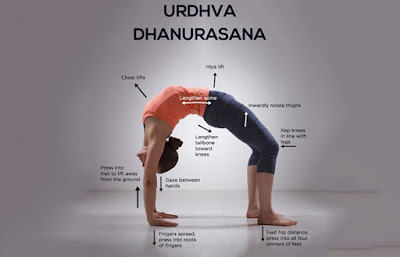 Technique :After lying on the ground on your back, spread both the legs and slightly open the feet. Then place both the elbows near the head on the ground. The palms should touch the ground. Then slightly lift the body and make the body round. But the feet should touch the ground. Stay in this position for some time.
Technique :After lying on the ground on your back, spread both the legs and slightly open the feet. Then place both the elbows near the head on the ground. The palms should touch the ground. Then slightly lift the body and make the body round. But the feet should touch the ground. Stay in this position for some time.
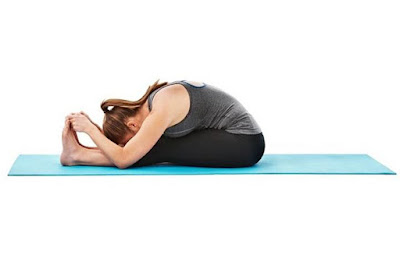 Technique :Spread the legs forward and sit on the ground. Touch the thumbs of the feet with the hands, slowly breathe out and try to place the head on the knees. Then slowly raise the head and come back to initial position. Repeat this Aasan for 10-15 times daily.
Technique :Spread the legs forward and sit on the ground. Touch the thumbs of the feet with the hands, slowly breathe out and try to place the head on the knees. Then slowly raise the head and come back to initial position. Repeat this Aasan for 10-15 times daily.
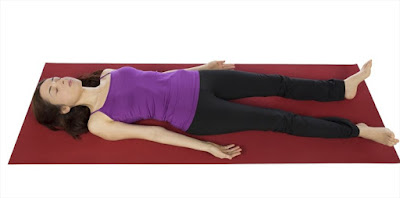 Technique :To perform Shav Asana lie down on the ground on the back and totally relax the body. Breathe long and slow. There should be a gap of at least 1 feet between the feet. Palms should be little away from the body and should face skyward. Close your eyes and think that body is relaxing. Feel that the body is resting. This asana should be performed for 3-5 minutes.
Technique :To perform Shav Asana lie down on the ground on the back and totally relax the body. Breathe long and slow. There should be a gap of at least 1 feet between the feet. Palms should be little away from the body and should face skyward. Close your eyes and think that body is relaxing. Feel that the body is resting. This asana should be performed for 3-5 minutes.
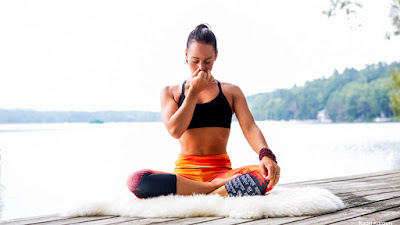 Pranayama is an appropriate control over the process of breathing. It refers to breathing exercises that are used for relaxation, concentration and meditation. There are following exercises of Pranayama :
Pranayama is an appropriate control over the process of breathing. It refers to breathing exercises that are used for relaxation, concentration and meditation. There are following exercises of Pranayama :
Share yoga poses and their benefits with others also. Tags exercises health yoga
